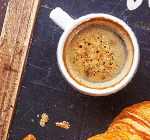
The Rise & Rise of Cafe Culture
You know it, love it, need it: coffee. Whether you drink it first thing in the morning, chug it down at 1 AM to stay awake, the world can simply be divided into ...
More
text and images . Pauline Chan .
The Durian - it smells, it's thorny, it'll hurt like hell if you drop one on your foot, but it's so loved that even the most elegant of humans will ditch style and dignity and sit/squat/perch by the road side for a helping of durians. Durians have to be sold in wide open spaces - its lingering pungent odor will never allow it to see the insides of a posh chandeliered-setting - so durian connoisseurs have to adapt to the road-side-dining concept to enjoy it, and enjoy it fresh.
Durian is the fruit of a perennial tree that can be cultivated in the tropics and bears fruit after 4-5 years, depending on the variety. Its life span can range from 80 to 100 years with a trunk diameter of 1.5 - 4.0 feet and height over 70 - 80 feet. A durian will fall from the tree when it is ripe so it is never a good idea to play hide-and-seek in a durian orchard. The durian fruit pulp is creamy and smooth, in shades of white, yellow, orange and red, depending on the type and breed. While the colour and texture varies, the smell is constant. It is strong, heavy, and pervasive. Some have described it as pungent, foul, smelly, nauseating, yucky, OMG (bad), even #@!&%^; yet hoards have called it beautiful, sweet, fantastic and OMG (good). The descriptions are varied and whatever the sentiment, it is a real-time reactive emotion - you have to smell it yourself to come up with your own word.
Wild species grow in the rainforest and their flavour and colour are vastly different from commercial durians. In Borneo, there are 2 varieties of durians available - yellow and white. The yellow type, durian kuning is the type that one fights over, however to some, it is an acquired taste as the bitter aftertaste is potent and lingering. They are petite little balls of thorns with smooth, creamy gems inside in mustard yellow, pumpkin orange or cooked-prawns-red - hence the name Durian Otak Udang Galah - and their flavour is distinctive to the colour they sport. The white variety, like ice cream, comes in a multitude of flavours for that one shade. Among the white durians, the tembaga and pulut are large varieties with sweet, creamy and fleshy pulp. Durian susu has a milky taste and creamy texture while the durian kahwin has a blend of flavours. There is a jungle variety named durian kura-kura that grows in a bunch from the lower part of the trunk. This particular durian has widely-spaced short spines, light yellow translucent pulp and is uncharacteristically odour-free and for durian fans, this species will probably be considered a bore.
Malaysian commercial durians are usually cultivated from a cross-breed of species. Scientific meddling has produced durian types that have specific textures, aftertastes, colours and aromas and some breeds have fascinating names while others have boring ones with a D suffix and a number. Malaysia has produced some award winners and they go by the names of Ang Hae or Udang Merah, which in D terms is D175, there is the D11, D600, D163, D177, Ang Jin (Hati Merah), Raja Kunyit, Kulit Hijau and Amy Yip - named after a buxomy Hong Kong actress from the eighties (I don't exactly know why but I can guess) and many other D durians.
If you are out scouting for durians, how would you know if a durian is good or fresh?
Here are some tips we learnt from David Ting - a durian purveyor in Bandar Seri Begawan who gave us the massively popular Durian Buffet Nights in Batu Bersurat FA Sports Cafe this month - for choosing a good durian:
Sight check - Look at the spikes. Widely-spaced thorns indicate fleshy content while narrowly-spaced thorns mean skinny helpings inside. Long, big thorns and thorns that grow inwards indicate a higher grade of fruit, so expect to pay premium price for it. Check the bottom, if it is cracked, it may be over-ripe but that is not necessarily bad. If the crack is less than 3 inches, the quality may not be affected. Take a peek inside and see if the fruit looks firm, then give it a try because it may still be delicious.
Smell check - Smell the durian, if there is a strong smell, highly likely that it's good. If there is no smell, it is probably not ripe yet.
Sound check - Scrape the durian surface with a small knife or anything solid that is handy, if it sounds crispy it is fresh because the thorns are still sharp and hard. Soft thorns mean they have been around for awhile and hence a duller sound is produced.
Shake check - Shake the durian and feel. If there is movement within, it is ripe and the texture will be good. A durian that produces no wobbling sound means its either unripe or the opposite - too ripe. Either way, the texture will be too hard or too watery.
Burrowing insect check - Look for holes around the durian, if there is a tiny hole somewhere, there could be a worm (larva of an insect) that has burrowed into it.
Yellow-shelled durians foretell sweetness, but that doesn't determine taste. Taste or flavour is a very individual thing. There is a variety of durian flavours: milky, creamy, bittersweet, plain bitter, XO flavour (a tinge of alcoholic aftertaste), nangka taste etc. Some people postulate that durians that droppped on their own has more flavour compared to those that were cut from the branches. That cannot be taken as a rule of thumb as it depends on the tree. Cut durians will ripen in 2 to 3 days and they can be very flavourful as well. Durian farmers can instinctively tell a good durian from the mediocre and they will not pick up every durian that has fallen to the ground. In general, look for durians with a green shell, widely-spaced thorns and the 'wobbly' sound when you shake it and you will likely have found a winner.
Now that you have selected your durians and you want to bring them home and open them yourself, this is what you can do: Hold the durian with a thick cloth wrapped round one hand to hold the fruit steady, or put on a pair of thick gloves, and then pick one of the methods below:
Professional fruit-seller style - use a short knife, one that is slightly bigger than the standard Swiss army knife, and poke at the base of the durian along the 'seams' and push the sections apart gently. Some species have no visible 'seams' at the base, so you have to poke the knife at various places to find that joint and once you find it, it will be easy to pry open.
Gangster-on-the-loose style - use a big knife, like a meat cleaver and hack along the 'seams' and then pry ruthlessly with the knife. (Tip: A durian knife can be bought for a mere few dollars at SKH supermarket and they come with a short, thick blade. It is the safer tool for durian enjoyment and will instantly polish the gangster-style into a professional one.)
What is not well-known is the health benefits of eating durians. Durians are loaded with phytonutrients, provide energy, have high amounts of proteins and antioxidant properties. Durian contains very high levels of Organosulphur compounds and Tryptophan. Healthy Communications.com highlighted that both have numerous benefits that aid a variety of health conditions.
Organosulphur compounds are antioxidant and anti-inflammatory, enhances the condition of hair and skin, improving joint flexibility, reducing stiffness, reducing inflammation, reducing arthritic pain, and they are known to inhibit platelet aggregation which is one of the first steps in the formation of blood clots that occlude coronary or cerebral arteries, leading to heart attack or stroke. Tryptophan has a biochemical benefit of inducing good sleep. Tryptophan is a precursor of the sleep-inducing substances serotonin and melatonin. This means Tryptophan is the raw material that the brain uses to build these relaxing neurotransmitters, promoting restful sleep. Tryptophan is used to treat conditions like insomnia, anxiety, stress, migraines, depression and other conditions. So, there you go: durians for a relaxing good time, and remember, they are best enjoyed with a group of friends.

The Rise & Rise of Cafe Culture
You know it, love it, need it: coffee. Whether you drink it first thing in the morning, chug it down at 1 AM to stay awake, the world can simply be divided into ...
More

Your Preferred Caterer has a New Website
Royal Brunei Catering has relaunched their website www.rbccatering.com which sports a more clean and contemporary look, last Wednesday.
More

the blind cook
The U.S. Masterchef's Season 3 premiered in the United States on June 4th and 5th. This season is somewhat different from previous seasons. Viewers get to see a ...
More